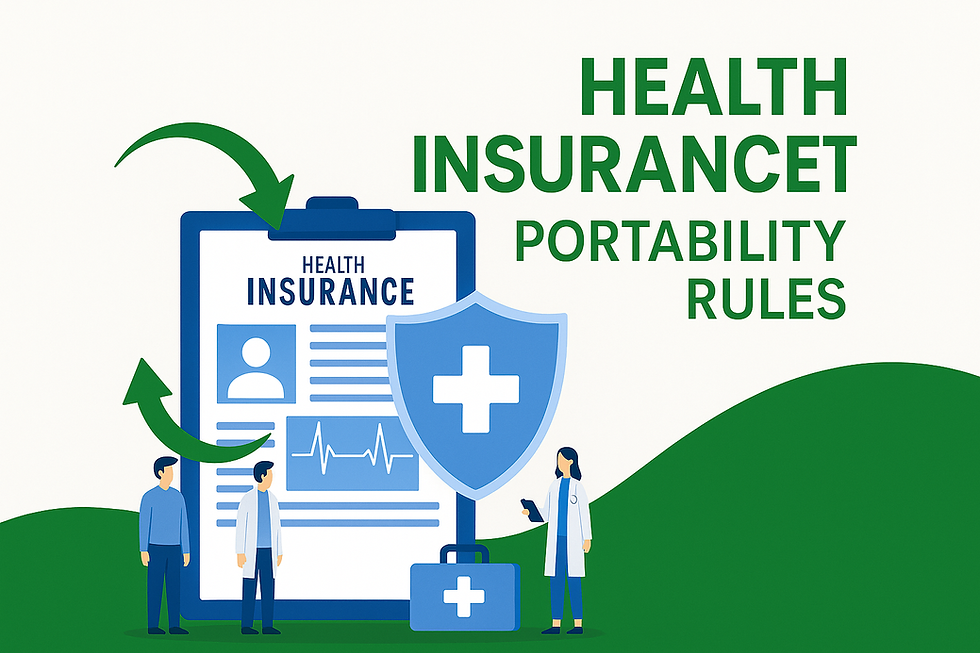Understanding Waiting Periods in Health Insurance
- Rohit Lokhande
- Aug 26
- 3 min read
Updated: Aug 26

Summary
Waiting periods in health insurance are often misunderstood but play a critical role in your coverage. They are the specified time during which certain claims cannot be made after purchasing a policy. From pre-existing diseases to maternity benefits, waiting periods affect when you can access full coverage. This guide explains the types of waiting periods in India and why understanding them is essential for choosing the right health insurance plan.
Table of Contents
What is a Waiting Period in Health Insurance?
Why are Waiting Periods Important?
Types of Waiting Periods
Benefits of Knowing Waiting Periods
Real-World Scenarios
Common Exclusions
Best Practices to Manage Waiting Periods
Regulatory and Indian Context
FAQs
What is a Waiting Period in Health Insurance?
A waiting period is the fixed span of time during which an insurance company will not accept claims for certain conditions, even though the policy is active. Once this period ends, coverage for those illnesses or benefits becomes valid.
Why are Waiting Periods Important?
Waiting periods help insurers manage risk and prevent misuse of policies. They ensure that individuals don’t buy insurance only after being diagnosed with a condition. For policyholders, understanding waiting periods is crucial to avoid claim rejections.
Types of Waiting Periods
1. Initial Waiting Period
Most policies impose a 30-day waiting period for all illnesses except accidents, which are covered from day one.
2. Pre-Existing Disease Waiting Period
Coverage for pre-existing medical conditions usually begins after 2–4 years, depending on the insurer.
3. Specific Illness Waiting Period
Certain illnesses such as hernia, cataract, or joint replacement have waiting periods of 1–2 years.
4. Maternity and Newborn Waiting Period
Maternity benefits are usually subject to a waiting period of 9–36 months before claims are allowed.
5. Waiting Period for Critical Illness Riders
Critical illness add-ons often come with their own waiting periods, typically 90 days.
Benefits of Knowing Waiting Periods
Helps avoid unexpected claim rejections
Allows better planning for elective treatments
Informs purchase decisions for families planning maternity cover
Ensures realistic expectations from the policy
Real-World Scenarios
A policyholder diagnosed with diabetes shortly after purchase may have to wait 3 years for coverage.
A couple planning a child should buy a policy early to ensure maternity benefits are accessible when needed.
Cataract surgery expenses are only claimable after serving a 2-year waiting period.
Common Exclusions
Claims made during waiting periods are rejected.
Pre-existing conditions not declared at purchase may result in claim denial.
Some genetic or lifestyle-related conditions may not be covered at all.
Best Practices to Manage Waiting Periods
Buy health insurance early in life to serve waiting periods sooner.
Disclose all pre-existing conditions honestly.
Compare insurers, as some offer shorter waiting periods.
Opt for plans with “reduced PED waiting period” add-ons if available.
Plan maternity or elective surgeries with policy timelines in mind.
Regulatory and Indian Context
Regulated by IRDAI (Insurance Regulatory and Development Authority of India).
As per IRDAI guidelines, insurers cannot impose waiting periods longer than 4 years for pre-existing diseases.
Standardisation of waiting period clauses ensures fairness across insurers.
FAQ's
1. What is the initial waiting period in health insurance?
It’s usually 30 days from policy start date, during which no claims are accepted except for accidents.
2. Do waiting periods apply to all illnesses?
Yes, except for accidental injuries, which are covered from day one.
3. Can waiting periods be reduced?
Some insurers offer riders or higher premiums to reduce waiting periods, especially for pre-existing diseases.
4. How long is the waiting period for maternity benefits?
Typically 9–36 months, depending on the insurer and plan.
5. Is diabetes covered immediately under health insurance?
No, diabetes is usually treated as a pre-existing condition with a 2–4 year waiting period.










Comments